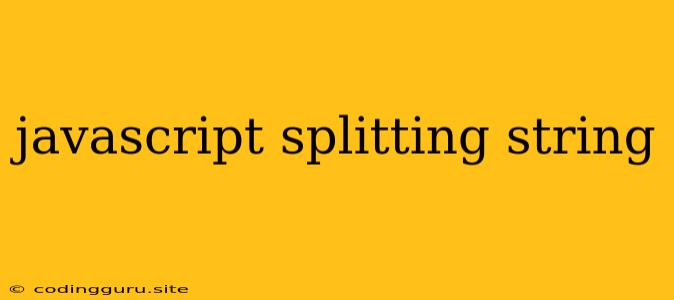Mastering the Art of Splitting Strings in JavaScript
Splitting strings is a fundamental task in JavaScript, allowing you to break down a larger string into smaller, manageable pieces. This process is crucial for various scenarios, from parsing data to manipulating text. In this article, we'll explore the ins and outs of JavaScript's string splitting techniques.
Why Split Strings?
Imagine you have a string containing a list of comma-separated values, like "apple,banana,orange". To work with each individual fruit, you need to separate them. This is where string splitting comes into play. By splitting the string based on the comma, you obtain an array containing "apple", "banana", and "orange", allowing you to process each item independently.
The Power of split()
JavaScript provides the split() method, which is the go-to tool for string splitting. It takes a delimiter (the character or pattern you want to split by) as its argument and returns an array of substrings.
Example:
let fruits = "apple,banana,orange";
let fruitArray = fruits.split(",");
console.log(fruitArray); // Output: ["apple", "banana", "orange"]
In this example, we split the string fruits by the comma delimiter, resulting in an array called fruitArray.
Beyond Commas: Using Regular Expressions
The split() method isn't limited to simple delimiters. You can leverage regular expressions to split strings based on more complex patterns.
Example:
let sentence = "This is a sentence with multiple spaces.";
let words = sentence.split(/\s+/); // Splits by one or more spaces
console.log(words); // Output: ["This", "is", "a", "sentence", "with", "multiple", "spaces."]
Here, we use the regular expression /\s+/ to split the sentence by one or more spaces, effectively separating each word.
Advanced Techniques
1. Limiting Splits:
You can limit the number of splits by providing a second argument to split().
let sentence = "This is a sentence with multiple spaces.";
let limitedWords = sentence.split(/\s+/, 2); // Splits into 2 parts
console.log(limitedWords); // Output: ["This", "is"]
2. Empty Strings as Delimiters:
If the delimiter is an empty string (""), the split() method will split the string at every character.
let string = "hello";
let characters = string.split("");
console.log(characters); // Output: ["h", "e", "l", "l", "o"]
Practical Applications of String Splitting
1. Data Parsing:
Splitting strings is crucial for parsing data from various sources like CSV files, JSON objects, or user input.
2. URL Manipulation:
You can extract different parts of a URL (like the protocol, domain, or query parameters) using split().
3. Text Processing:
Splitting strings is essential for manipulating and analyzing text data.
Conclusion
Mastering string splitting in JavaScript is a fundamental skill for any developer. By understanding the split() method and its capabilities, you can efficiently break down strings into smaller components, paving the way for powerful data manipulation and text processing.
